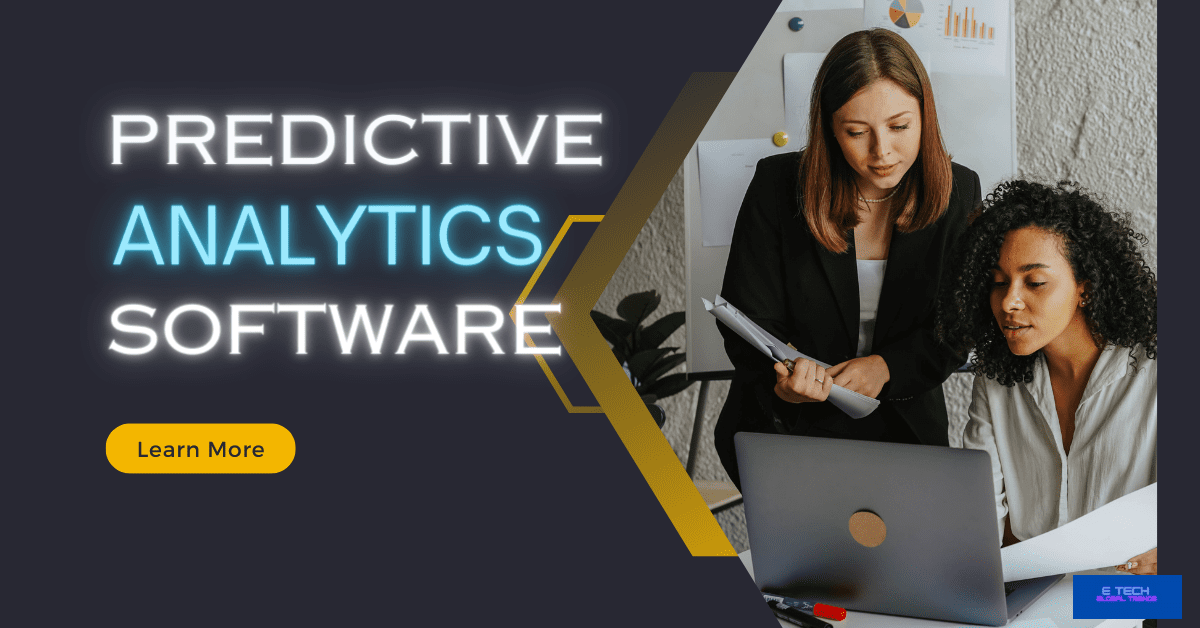Predictive analytics tools
They now become crucial for entrepreneurs.
What is predictive analytics software?
A type of advanced analytics is called predictive analytics. BY evaluating historical data and making future predictions.
As the name suggests, predictive analytics uses the following techniques.
- Data mining
- algorithms,
- machine learning
- statistical modeling techniques
to estimate likely future events and trends.
In order to forecast something that is not now in your database, the data is analyzed using AI and machine learning.
Predictive analytics is the process of calculating the likelihood of future events based on historical data by using data, statistical algorithms, & machine learning techniques. It combines historical data, subject-matter knowledge, and statistical algorithms to provide forecasts.
Predictive analytics may help;
- businesses make wise decisions by providing insights into upcoming trends,
- customer behavior, and
- market conditions.
In BI software, predictive data analytics has the power to identify opportunities for;
- action,
- foresee threats, and
- assist users in controlling risks.
If the data is sufficient and accurate, it can produce recommendations for any time period.
Isn’t it awesome?
why, these business tools are there to do so.
The primary goal of predictive analytics software development is to facilitate faster data processing and model construction. Since most analytics software lacks AutoML capabilities, it is unable to choose models on its own.
Even if it did, the majority of data problems still call for the application of a sizable amount of domain expertise to address them.
Due to the huge diversity of business difficulties that exist, it is quite challenging to develop this inside of a single software package.
What are the top software solutions for predictive analytics?
Predictive analytics tools may help business consultants, analysts, as well as data scientists make wiser judgments.
Predictive analytics software is a tool that builds future-looking models using machine learning techniques.
- Data scientists,
- analysts, and
- business consultants
use it to forecast the future and improve decisions made today.
The wonderful thing is these systems are not just available to major corporations. small-scale company efforts may also use them to make better decisions.
The most effective predictive analytics software combines both prescriptive and predictive analysis. In addition to having the capacity to forecast the future by analyzing existing data, they may also influence it by offering ideas.
Predictive analytics software products come in a variety of forms and are accessible to companies of all sizes.
What are the exact role-playing automated trading platforms and predictive analytics?
To optimize investing decisions!
Really? Yes, it is possible!
You may utilize automated trading software and prediction analytics to assist you in making wise judgments. Trends are predicted using predictive analytics, and trades may be executed using automated trading algorithms based on such predictions.
These are not only one-time Apps. rather, they have the ability to be included in a complete software suite in which all other components cooperate to deliver the finest outcomes for your company.
You’ll be able to do this to improve all of your company’s processes, including customer service, sales, marketing, and inventory management.
Here are a few examples of business analytics tools
- SAS:
- IBM Cognos:
- Oracle Data Mining: data mining & predictive analytics feature offered by Oracle’s Advanced Analytics Database Option.
1.0 Microsoft Excell
Excel is useful to do fundamental regression analysis along with additional statistical modeling techniques. despite not being primarily created for predictive analytics.
a well-liked data analysis program with many capabilities for data mining & analysis.
2.0 Google Analytics
Retailers may watch consumer activity on their website with this free application, which offers insightful data that can be incorporated into predictive models.
3.0 IBM SPSS.
SPSS has a robust collection of predictive analytics tools that could potentially be used to create intricate models, despite being slightly more costly than some of the other solutions on our list.
4.0 RapidMiner
Numerous capabilities, such as data preparation, modeling, and visualization, are available in this open-source data mining application.
A complete platform for data preparation, machine learning, deep learning, and predictive analytics is RapidMiner Studio.
5.0 Weka
Weka is a user-friendly and simple-to-learn open-source data mining tool.
What are the additional effective web resources for mining and analyzing huge datasets?
There are a number of useful web tools for the analysis and mining of massive datasets.
such as;
1.0 Google Sheets
a spreadsheet application for storing, organizing, and analyzing data that is cloud-based.
2.0 Tableau Public
This is a free platform for data visualization that makes it simple for users to connect, display, and share big information.
3.0 Analytics Platform KNIME
This platform is for data analytics, reporting, and integration that is open source.
How are business Predictive analytics tools used for a small business?
This is an example of when it’s a restaurant
By enabling precise forecasting, streamlining resource allocation, and enhancing customer service, predictive analytics may have a major influence on a small business as a restaurant.
1.0 Forecasting sales
Sales may be predicted using predictive analytics based on previous data, the weather, nearby events, and seasonal tendencies. This aids in the effective management of resources, such as inventories and manpower.
2.0 Consumer Demand Forecasting
It allows the restaurant to modify worker numbers and menu options in accordance with predicted client demand at various periods of the day or week.
3.0 Inventory Control
The amount of components needed may be predicted using predictive models, reducing waste and guaranteeing that the essential materials are always available.
4.0 Analyses of Customer Behavior
Analytics may be used to spot trends in consumer behavior, such as favorite foods or busiest times, which can aid with marketing plans and promotional deals.
5.0 Menu Improvement
Predictive analytics may offer insights on what to maintain, eliminate, or add to the menu by examining what items on the menu are popular while other ones are not.
Software tools for predictive analytics are excellent at forecasting outcomes that are challenging for people to anticipate. Traffic trends, fraud detection, customer attrition rates, and projections of marketing spend are a few instances of this. To anticipate trends within certain sectors or industries, these models can also leverage data from other sources, such as social media or online Of course, there is specialist analytics software made to address certain business issues. These software programs are designed to assist you with data analysis by performing the tasks that a data scientist typically performs, however, they only offer a small set of tools and solutions for certain issues. A data scientist will have to build everything that is not already included in the platform on a bespoke basis.
There will be less demand for data scientists to develop code as time goes on
So, this is the present trend but there is going to be a demand for a human specialist. because software cannot handle all edge situations on its own polls.
What are the primary market trends for Comprehensive Predictive analytics tools and what factors are driving their growth?
The need for real-time analytics is rising, and cloud-based solutions are becoming more widely used, which is fueling the market for advanced predictive analytics software. The market is expanding as a result of the increase in big data and the demand for data-driven decision-making.
Using predictive analytics in conjunction with AI and ML technologies is one of the major developments in the sector.
As a result, more complex and precise prediction models can find emerging trends. And also patterns.will create huge datasets.
The use of various predictive analytics software across a variety of sectors, including banking, and manufacturing, is another market trend.
The use of Predictive analytics tools helps businesses;
- run more efficiently,
- improve customer satisfaction, and
- create better products.
Additionally, the increasing need for predictive analytics software is pushing companies to develop cloud-based solutions.
that offer-
- Cost-effectiveness.
- Scalability.
- Flexibility
Cloud-based solutions also make it simple to integrate with other programs and apps, allowing businesses to make use of their current infrastructure.
Another development in the industry is the rise of sophisticated analytics platforms. That can combine predictive analytics with additional analytics tools like…
- data visualization and
- reporting.
These platforms give businesses a thorough analytics solution that may serve their needs as a company. and help them make data-driven choices.
What distinguishes business intelligence from predictive analytics?
Of course, they are not exactly the same!
Business intelligence vs. predictive analytics
Utilizing data and statistical algorithms, predictive analytics makes predictions about the future based on the past.
It is a form of sophisticated analytics that enables businesses to make proactive choices and take preventative measures.
The term BI- stands for “business intelligence“. ( read our article here)
It refers to the systems, procedures, and tools used by businesses to collect, organize, access, and analyze data in order to support business decisions.
Technologies and methods for gathering, integrating, and evaluating data from multiple sources are part of BI.
By offering companies access to data and insights they can use to enhance their operations and performance, it enables them to make data-driven choices.
In conclusion, predictive analytics refers to the branch of advanced analytics that involves the use of data and statistical formulas to make predictions about the future.
A collection of instruments, procedures, and methods known as business intelligence are used to collect, organize, and analyze data in order to assist corporate decision-making.
Predictive BI Analytics with AI
The trend continues…
The fusion of cutting-edge machine learning and artificial intelligence technologies will determine the direction of marketing analytics in the future. Businesses will be able to predict consumer behavior, spot patterns, and improve marketing campaigns for greater customer retention and higher conversion rates thanks to predictive analytics.
What are the uses of predictive analytics?
Marketing
Marketing uses predictive analytics to identify customer preferences and adjust marketing tactics.
Healthcare,
For instance, healthcare professionals utilize predictive analytics to pinpoint patients who are more likely to contract particular illnesses or diseases.
Finance,
Forecasting stock prices, and spotting potential fraud are two financial applications of predictive analytics.
predictive analytics to better manage inventory and predict demand.
Retail
Retail uses predictive analytics to better manage inventory and predict demand.
are just a few industries that employ predictive analytics.
Apart from that,
1.0 Demand forecasting
Predictive analytics may be used by businesses to calculate the demand for their goods and services. By analyzing past sales data & market trends, businesses may identify trends that point to future demand. Planning for manufacturing, pricing, and inventory management may all benefit of this information.
2.0 Healthcare Forecasts
Healthcare organizations employ predictive analytics to pinpoint patients who are most likely to get a given disease or sickness. Examining patient information including medical history, lifestyle choices, and genetic data can help healthcare professionals find patterns that point to a patient being at risk. To develop personalized preventative and therapeutic strategies, this data may be used.
3.0 Fraud Detection
For businesses in the financial sector, fraud is a major concern. To identify fraudulent transactions prior to they happen, businesses can utilize predictive analytics. By examining transaction data, businesses can identify patterns that point to fraudulent activity.
This information can use to utilize and develop algorithms that can instantly mark dubious transactions for further investigation.
4.0 To predict customer churn
For firms in all types of sectors, customer turnover is a key worry.
Predictive analytics is now can use for businesses to identify customers.
“who have a tendency to leave in the future.”
By looking at consumer data including;
- purchase history,
- customer interactions,
- including demographic data,
businesses may identify patterns that imply a client is likely to leave. To prevent customers from leaving, to develop targeted retention strategies, this data is useful then.
How do I become a dynamic predictive analyst?
Of course, it is possible!
One requires a solid background in statistics, machine learning, & data analysis to become successful in predictive analytics.
The following are only a few of the crucial abilities needed to understand predictive analytics:
A. Statistical Analysis
Statistical analysis is a key component of predictive analytics. It is necessary to be familiar with statistical ideas including probability theory, regression analysis, and hypothesis testing.
B. Machine Learning skills
The goal of machine learning is to create algorithms that are capable of learning from data. It is a part of artificial intelligence.
Different machine learning methods,
Including;
- Decision trees,
- Regression analysis, &
- Neural networks
are a must!
C. Data Analysis
Working with massive datasets is necessary for predictive analytics. Data processing, data visualization, and cleansing should all be easy for one to do.
Summary
Although software programs might be useful, it’s crucial to remember that they only make up a small portion of the predictive analytics puzzle.
In addition, you must have a firm knowledge of statistical modeling methods and a thorough comprehension of the business issue you’re attempting to resolve. Consider consulting with a consultant if you’re unsure about where to begin.
Hope this effort is helpful.
Cheers!
Read more on related topics here; business analytics, machine learning for business








Nice post. I learn something new and challenging on blogs I stumbleupon on a daily basis. It’s always interesting to read through content from other writers and use something from other web sites.